
Chris Kilham with Hops (Humulus lupulus) in France. Photo courtesy of Nebil Bourguiba.
Driving along picturesque country roads toward Castelculier in the Nouvelle-Aquitaine region of southwestern France, it’s easy to become enchanted with the place. Verdant forested hills adorn a rural landscape featuring immaculately kept crops of strawberries (Fragaria spp., Rosaceae), kiwis (Actinidia spp., Actinidiaceae), hazelnuts (Corylus avellana, Betulaceae), melons (Cucumis spp., Cucurbitaceae), wheat (Triticum spp., Poaceae), corn (Zea mays, Poaceae), tomatoes (Solanum lycopersicum, Solanaceae), and the famous Agen prunes (Prunus domestica, Rosaceae), which even have their own museum in Lafitte-sur-Lot. The forests are renowned for their abundant wild porcini mushrooms (Boletus edulis, Boletaceae). The air is clean and fresh. Streams ramble along here and there. You could imagine leaving your worldly cares behind, living in one of the many tidy stone houses scattered throughout the quaint villages of the area, and wandering the local outdoor farmers markets on sunny days, while finally writing your novel. It’s that kind of place.
My travel partner, Nebil Bourguiba, and I are on our way to witness the harvest of a plant product perhaps not often associated with France: hops (Humulus lupulus, Cannabaceae). We’re there to gather information on behalf of Groupe Berkem, a botanical extraction company based in Blanquefort, France. It’s September 2024, and the scenery is superb. Nebil, Berkem’s plant sourcing manager, and I head up the company’s Global Plant Exploration program, investigating plants and the people who work with them in the places from where they derive. This is ethnobotany in trade, diving deeply into the agricultural, cultural, economic, social, phytochemical, historical, and health details of various botanicals. We are not the only people doing this work. Savvy botanical suppliers all over the globe send buyers, agricultural experts, and ethnobotanists into the field to understand all aspects of botanical value chains from field to finished product and to become familiar with the people, conditions, and factors involved with specific plant crops. This kind of on-the-ground understanding cannot be gleaned via phone calls, websites, conferences, or Zoom calls. If you wish to truly know the plants in the botanical trade, you must get into the field; and if you wish to discover new botanicals and meet new sources, you need to roam.
On this road trip, we are headed to meet Lucie Le Bouteiller, president of Hopen-Terre de Houblon (Hopen), a hops manufacturer and supplier based in nearby Nérac, at a farm run by one of Hopen’s 10 suppliers, the hop farm and brewery known as Houb’s. In 2018, with degrees in hand from AgroParisTech, Lucie and her friend Fanny Madrid started Hopen, excited by the growth potential of a sustainable, high-quality hops business.
Based on inaccurate weather forecasts, we have prepared for a rainy and overcast day with hats and anoraks, but the sun is out and bright. Still, recent heavy rains have soaked the area, and our boots will be thoroughly weighed down by sticky mud in no time at all. It’s always something on the medicine trail!
Pulling into the Houb’s farm, we see more than 20 long rows of hop plants on their last day of cultivation. Lucie and a Bordeaux video crew consisting of Catya, Alexandre, and Matteo are waiting for us to document the scene. A harvesting truck is moving into position to begin pulling down seven-meter-high hop vines that are trellised on slender ropes attached to wires spanning between wooden poles. There’s a husky aroma in the air reminiscent of cannabis (Cannabis sativa, Cannabaceae), a botanical cousin of hop.
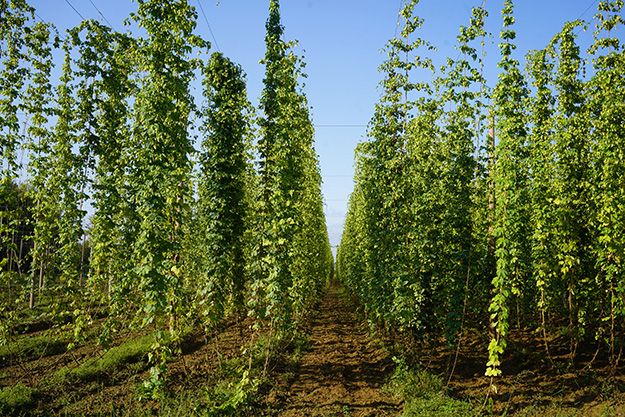
Rows of hop vines at Houb’s farm in Castelculier, France. Photo ©2025 Chris Kilham
In Hops
In preparation for our journey to the hops harvest, I have taken a deep dive into the plant, its history and uses, current science, and phytochemistry, as well as agricultural and historical information about the Nouvelle-Aquitaine region. I come bearing maps, two helpful guidebooks, a notebook, and two cameras. Nebil is prepared as well; he has sought out specific information on supply, costs, and quality control, and he carries a drone for aerial filming. The more you know about a botanical before investigating it in the field, the better you can understand what you witness and experience. This greatly enriches the experience.
Hops refers to the cone-shaped female inflorescences of Humulus lupulus L. The species name lupulus is Latin for “small wolf.” In his Naturalis Historia (77 CE), the Roman naturalist Pliny the Elder (23–79 CE) explains that this name refers to the way hop vines climb and cling, often suffocating other plants, in a manner similar to the way wolves cling to their prey. Hop is one of two plants of significant economic value in the Cannabaceae family, the other of which is Cannabis sativa.* Hop is an herbaceous perennial liana (woody vine) that yields a dense profusion of cone-shaped inflorescences. These cones, botanically known as strobiles, are composed of soft, light green resinous petals. When mature, hop strobiles are covered with lupulin glands, which yield resins and essential oils that contribute to the distinctive flavors and aromas of hop varieties. Native to Eurasia and likely originating in China, hop reached what is today the European continent approximately one million years ago. As far as we know, hop has been cultivated for over 1,000 years. Though climbing hop plants are generally referred to as vines, they are technically bines. While vines use tendrils and suckers to grip and grow upward, bines grow in a clockwise helix, binding to a central support, which in the case of cultivation is a slender rope. Still, I’ve never heard anybody refer to them as bines. So, vines it is.
Nebil and I greet Lucie and the video crew in front of several long rows of fresh green hops. A light breeze blows, making a soft shushing sound as tens of thousands of strobiles flutter against each other. It’s the kind of sound that, if you played a recording of it beside your bed, would gently lull you to sleep. After exchanging greetings, Lucie tells us about the hops-growing industry in southwestern France and the burgeoning demand. In 2023, France ranked first in Europe in the number of craft breweries, with a market worth an estimated €300 million in France alone. Hopen’s business is thriving and is based on collective success along the whole hops value chain — ensuring fairness and justice for all participants, supporting a healthy ecology, and staying local. Lucie is enthusiastic about hops and about the success of her company. Hopen pelletizes hops for the brewing industry and makes hops available in other forms for extraction.
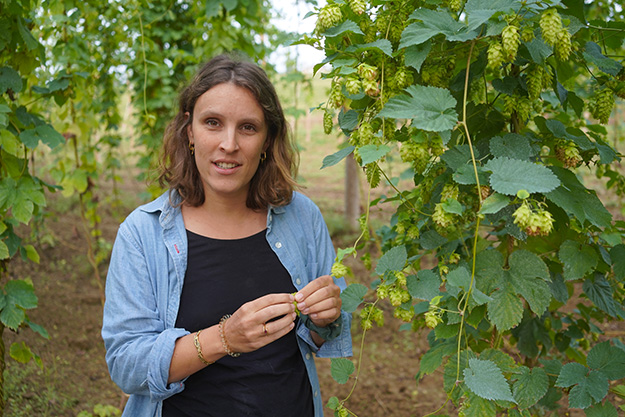
Hopen co-founder Lucie le Bouteiller among cultivated hop plants. Photo ©2025 Chris Kilham
Hopen offers 17 varieties of hops to the market and emphasizes organic cultivation. The hops they offer vary according to alpha and beta acid values, with the Alpha Roma variety the most concentrated in these. (These acids are largely responsible for the bitter flavor of some beers. The difference between yields of organic and conventional cultivation of this plant is significant, with organic methods yielding approximately 1,600 kg of dried strobiles per hectare and conventional yielding approximately 2,200 kg per hectare. But organic cultivation, with its superior soil-enrichment methods, results in hops with higher concentrations of desirable compounds. Even in a competitive and price-driven botanical market, there is room for well-positioned ultra-fine-quality organic botanicals.
Several varieties of hops grow on Houb’s property, including Chinook, Cascade, Centennial, Galena, Crystal, and Willamette, with more rows of Cascade hops than any others, as this variety is one of the most popular. These varieties look very much the same as one another, but their flavor and aroma profiles differ. For example, Cascade hops possess floral, citrus, resinous, and grapefruit (Citrus × paradisi, Rutaceae) notes, as compared with Galena hops, which possess spicy, fruity, and blackcurrant (Ribes nigrum, Grossulariaceae) notes. Since 2021, Houb’s has increasingly converted production to organic, with an emphasis on yielding higher concentrations of alpha acids and aromatic essential oils in their hops.
Most of the dried hops and hops pellets produced and supplied by Houb’s and Hopen go to the beer brewing industry, where brewmasters require the flavors and aromas of different hops varieties for unique brews. The proliferation of brewpubs, microbreweries, and artisanal beer makers has driven demand for more tonnage of hops with more unique characteristics. Demand from the nutraceutical and fragrance sectors also is pushing production.
As soon as we exchange greetings with Lucie and the video crew, the idling harvesting truck gets into gear. A man stands on the back of the truck as it maneuvers between two lines of hop vines, and the harvest begins. As the truck rumbles along, the man on the back pulls down strings of hops, which have been snagged by the front of the truck and disengaged from the wire lines that hold them, dropping the hops onto the truck bed. Rolling ahead slowly in first gear, the truck is filled with high stacks of hops in a very short time. When the truck bed is filled higher than the man pulling the strings, the hops are taken to a large industrial shed nearby, where drying and sorting take place. There, the unwieldy piles of hops are deposited on the shed floor and fed by hand onto a conveyor belt. The truck returns to the hops field and harvesting resumes.
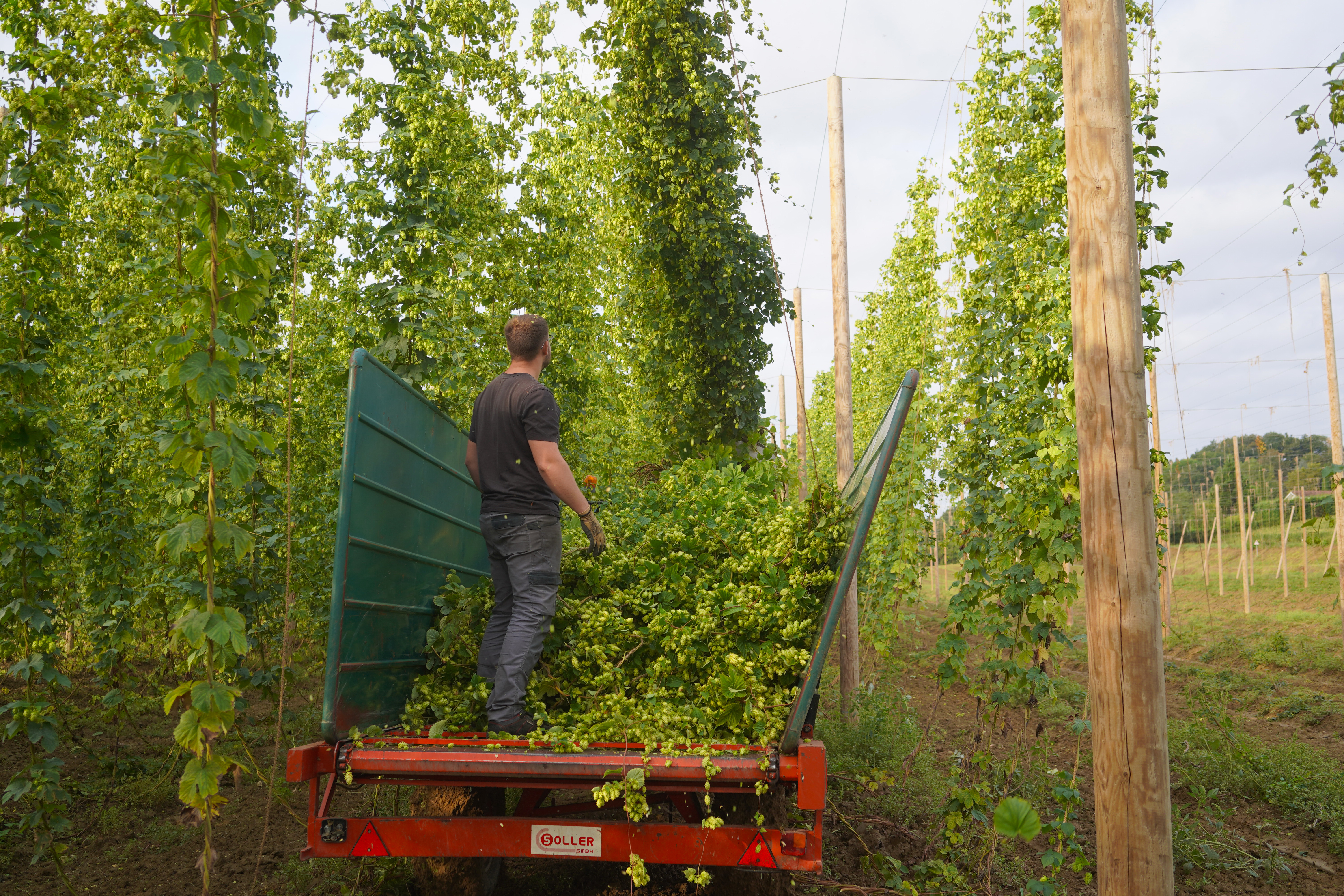
Harvesting hops on a truck. Photo ©2025 Chris Kilham
As the harvesting truck moves down long rows of hop vines, I take dozens of photos, Nebil flies a drone, and the video crew captures the harvest in 4K resolution. Images and video footage are valuable tools not only for documentation of what we experience, but also for educational presentations and social media. Today’s digital landscape offers a great range of platforms to share ethnobotanical research. Not everyone can get out into the field to investigate botanicals, but through digital media, we can at least partially bring the field to others. Sharing these types of images and information helps to bridge worlds and foster better understanding between suppliers and customers who may be geographically very distant from one another.
Hops in Beer
The oldest known beer recipe, which does not include hops, dates to 1800 BCE in Sumer in a paean to the beer goddess Ninkasi (whose name means “you who fill my mouth so full”). Translated from clay tablets by University of Chicago Sumerian scholar professor Miguel Civil, PhD (1926–2019), the “Hymn to Ninkasi” contains specific enough brewing instructions that Fritz Maytag, founder of San Francisco’s Anchor Brewing, made beer from this recipe for the 1989 meeting of the American Association of Micro-Brewers. Served in huge jars, Maytag’s Sumerian beer was a big hit. In March of 1993, Maytag took the Sumerian beer on the road and served it to the public at a beer seminar at the University of Pennsylvania’s Museum of Archaeology and Anthropology. A few days later, The New York Times published a feature article about Maytag’s crafting of this brew, titled “The Beer That Made Sumerians Famous.”
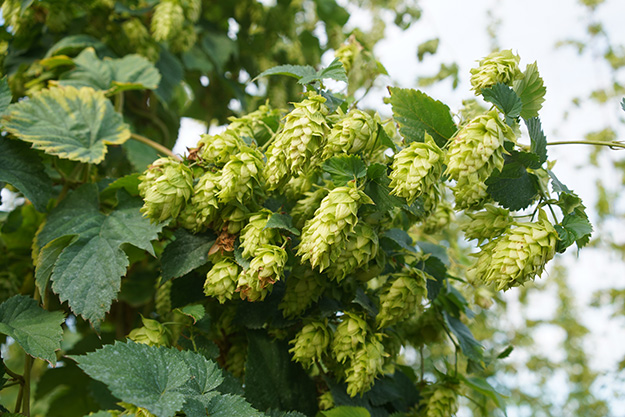
“When you pour out the filtered beer of the collector vat,
It is like the onrush of the Tigris and the Euphrates.”
—From the “Hymn to Ninkasi”
Beer changed in 1079 in Germany when hops were added to beer recipes for the first time. Some people have suggested that beer brewing with hops in Finland was practiced during prehistoric times, but this claim has yet to be well substantiated. The bitterness, complex flavors, and aromas of hops won over beer drinkers, and today the primary industrial use of approximately 98% of all cultivated hops is for the beer brewing industry, with the United States being the world’s largest producer. More than 170 varieties of hops are cultivated globally, offering a profusion of flavor notes from citrus to floral to piney and much more.
According to the US Department of Agriculture, over 52,000 tons of hops were produced in the United States in 2023, valued at approximately $562 million.6 Dried hops are feather-light, so this tonnage is virtually mountainous in volume. Hops serve a dual purpose of preserving beer and imparting bitterness. In fact, there is a standardized unit of measurement for the bitterness of beer called the International Bitterness Unit (IBU). The “hoppiest” style of beer is the IPA, or India Pale Ale. This style was developed by British brewers in the 1700s to preserve beer during long shipping voyages to India. Today, “Hoo Lawd” beer from Dogfish Head Craft Brewed Ales in Delaware is purportedly the most heavily hopped beer ever documented.
But Nebil and I are not at Houb’s meeting with Lucie le Bouteiller and observing the hops harvest for the brewing industry. Rather, our venture concerns nutraceuticals that harness the broad health-promoting properties of hops in extracts.
An Organoleptic Feast
Hops appeal to the senses in an enticing manner. I have previously described the pleasing shushing sound made by strobiles fluttering together in a breeze. Hops are beautiful to behold and delicate in appearance, offering pretty shades of light green. In sunlight, the strobiles sparkle due to the resinous lupulin glands that cover them when they are mature. They appear anodized, almost bioluminescent in their sheen.
Approaching a string of hop vines, I take several in my hand. They are sticky with resin, tacky to the touch. Hops are covered with both soft and hard resins. The soft fraction consists of the bitter acids humulones, lupulones, humulinones, hulupones, waxes, and fats, while the hard fraction contains 4’-hydroxy-allohumulinones and tricyclooxyisohumulones and various phenolic compounds. Resins make up 10% to 30% of dried hop cones, with both resin fractions contributing to the flavor and aroma of beer – in addition to the phenolic constituents. The resin covering the hops reminds me of late-stage cannabis when flowering buds become tacky with resinous, cannabinoid-rich trichomes.
I lean in closely and smell the hops. These botanical cousins of cannabis, which diverged evolutionarily an estimated 28 million years ago, both have sticky inflorescences and somewhat similar fragrances. This is due to their common aromatic terpenes. Myrcene, linalool, geraniol, limonene, caryophyllene, and humulene are found in the resins of both plants. The aroma is pleasing and may also be therapeutic for brain and mood. A significant body of evidence shows that various terpenes permeate the blood-brain barrier, purportedly protecting nerves and providing anti-inflammatory protection to the brain and reducing oxidative stress. Essences of hops are used in perfumery to impart a “green” aroma. There are at least 22 hops-containing fragrances on the market today, 16 of them unisex, according to the perfume website Fragrantica.
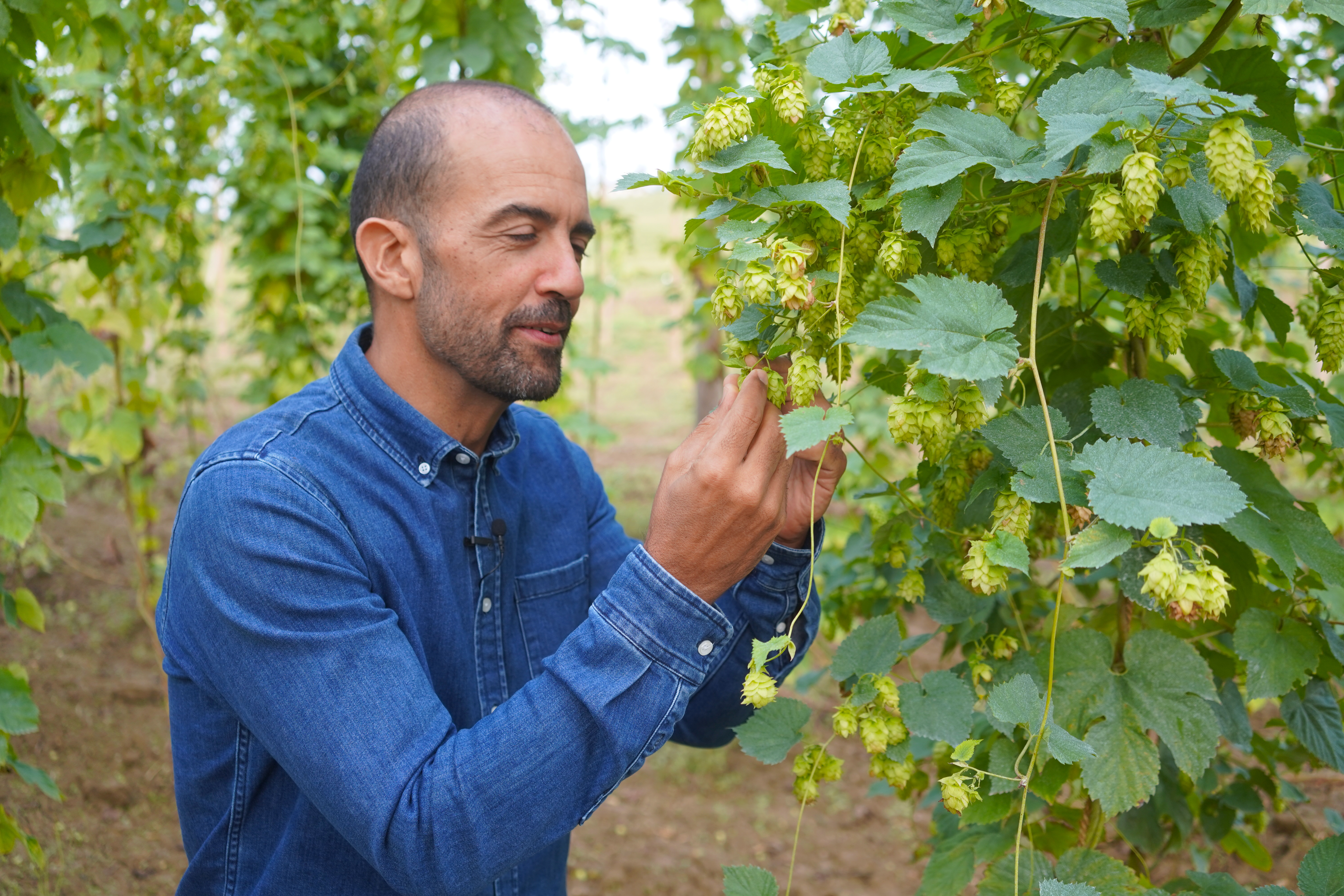
Nebil Bourguiba delights in the scent of hops. Photo ©2025 Chris Kilham.
The next organoleptic venture is taste. Hops stand out as titans of flavor. I pick some petals, pop them in my mouth, and roll them around a bit. The bitterness comes on instantly and strongly. But it is not a flat bitterness. Instead, it tastes complex. This is very much the case, as the bitter principles in hops include the alpha acids humulone, cohumulone, adhumulone, prehumulone, and posthumulone, and the beta acids lupulone, columulone, adlumulone, prelumulone, and postlumulone. Additional flavor agents in hops include sulfur compounds, aldehydes, alcohols, esters, ketones, lactones, phenols, and terpenoids. In hops, these compounds yield a broad range of flavors and aromas reminiscent of fruits, flowers, woods, grasses, musts, tobacco, spices, leather, nuts, and vegetables. Among the varieties of hops cultivated around the world, the flavors and aromas can and do vary greatly. The variety, place of cultivation, soil fertility, overall composition, sun, rain, and other agricultural and environmental factors determine which flavors and aromas — fruity, woody, smokey, floral, earthy — are expressed.
Health-Promoting Hops
Hop strobiles comprise an impressive natural medicine chest, containing compounds that demonstrate anti-inflammatory, cardioprotective, antioxidant, sedative, estrogenic, antibacterial, and anti-cancer properties. Over 1,000 compounds have been found in hops, a dazzling array of phytoconstituents.
The first known reference to hop as a medicine is attributed to the Persian physician Mesue the Elder, or Abu Zakariya Yuhanna ibn Masawaiyh (ca. 777–857), who noted the anti-inflammatory activity of the plant. Virtually every chronic health disorder involves inflammation, and hops antioxidants inhibit the proinflammatory factors NF-kB (nuclear factor-kappa B), TNF-α (tumor necrosis factor-alpha), and COX-2 (cyclooxygenase-2) and inflammatory cytokine events. Beer, too, demonstrates protective activity against oxidative damage of DNA. This protection appears directly proportionate to the amount of phenolic hops constituents in the beer. The “hoppier” the beer, the greater the protection, making IPAs the most protective style of brews. However, beer makes a poor medicine for regular use due to the deleterious effects of alcohol on the liver.
Hops are powerhouses of cellular protection and rich in biologically active beneficial antioxidants, including catechin, epicatechin, quercetin, kaempferol, rutin, astragalin, myricitin, flavonol glycosides, flavanol dimers, oligomeric flavonols, tannins, ferulic acid, prenyflavonoids, multifidol glucosides, resveratrol, and xanthohumol. These compounds not only protect hop inflorescences from premature destruction due to exposure to heat, light, air, moisture, and time, but also act as protective factors in the human body to combat ongoing cellular-corrosive effects of reactive oxygen species. Antioxidants in hops also offer cardioprotective benefits, reducing oxidation of cholesterol and lipids in the blood, inhibiting platelet aggregation, and enhancing the strength and integrity of the heart and blood vessel walls.
The European Scientific Cooperative on Phytotherapy (ESCOP) confirms the sedative properties of hop strobile and lists therapeutic indications as “Tenseness, restlessness and sleep disorders.” Germany’s Commission E monograph does the same, giving indications for hops for calming and sleep. Hops pillows are an old approach to the tranquility-promoting effects of hops aroma. Hops tea before bed is a traditional remedy for promoting sleep. Purportedly, the sedative properties of hops became somewhat better known during the early days of cultivation in the Middle Ages when it was observed that people who worked in hop fields became drowsy. Whether by airborne aromatic compounds activating the olfactory bulb or hypothalamic sleep centers of the brain, or by absorption via the skin, or all of the above, workers found themselves in the soothing thrall of hops.
Containing 8-prenylnaringenin, one of the most potent phytoestrogens known in the plant kingdom, hops preparations are used as natural, plant-based estrogen replacements by women during menopause, providing relief from hot flashes, insomnia, and mood swings. In one study of 63 women, administration of a vaginal hops preparation proved as effective as vaginal estradiol for reducing menopause-related vasomotor symptoms and hot flashes.
Hops have been used to preserve food since ancient Egypt. The antimicrobial effects of hops are well-established thanks to the beer brewing industry. The bitter alpha and beta acids demonstrate antimicrobial activity and have been shown to inhibit the growth of several microbes, including Staphylococcus aureus, Streptococcus faecalis, Staphylococcus epidermidis, Streptococcus mutans, as well as species of Micrococcus, Mycobacterium, Listeria, and Clostridium, among others.
Hops extracts of different types have also demonstrated significant antitumor properties in vitro by interfering with the biological pathways of various types of cancer cells. Hops extracts have been shown to inhibit the growth and development of cancers of the skin, colon, bones, prostate, alimentary tract, and lungs. Much of this activity appears to be due to the presence of xanthohumol and isoxanthohumol, which are especially abundant in European varieties of hops.
Into the Dryer
In the field, the hops are harvested one variety at a time from their respective rows and then hauled a short distance to the drying facility in a large, galvanized aluminum shed. Large piles of hop vines are fed onto a conveyor belt that takes them up into a shaking area where the strobiles are separated from the stems and growing ropes. From there, any other unwanted materials are shaken out. I climb some steps beside the first conveyor belt and watch hop cones fall through the holes in the shaker to another conveyor belt below. From this point, the hops go through hand inspection and cleaning, and from there into warm air drying. The drying process is similar to that of tea (Camellia sinensis, Theaceae) drying, applying warm, circulating air that gently dries but does not brown or burn the plant material.
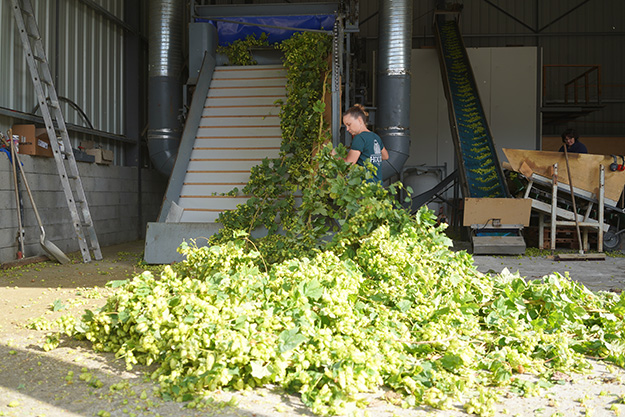
A worker loading hop vines onto a conveyor for sorting and drying. Photo ©2025 Chris Kilham
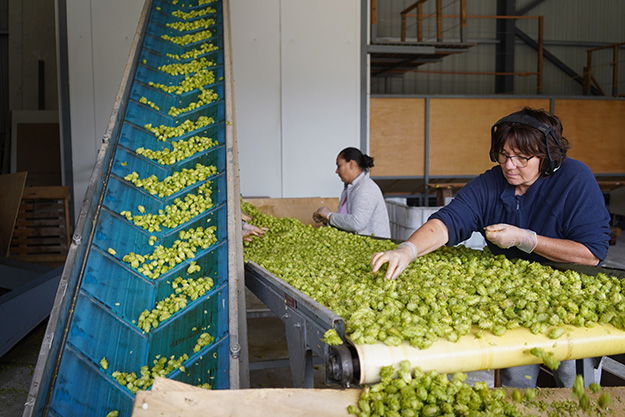
Workers sorting and cleaning hops by hand. Photo ©2025 Chris Kilham
With the strong connection between hops and beer, it only makes sense that at Houb’s there is a boutique brewery just feet away from the drying facility. After a stimulating tour of the hop fields, a beer seems the perfect beverage. Neat and bright, the facility proudly displays several styles of beers, including pale ales and golden blond ales, made with hops from the farm. The brewery attracts locals and tourists alike, as does the brasserie run by Houb’s just uphill from the drying area. Tour, drink, eat — a recipe for an enjoyable visit.
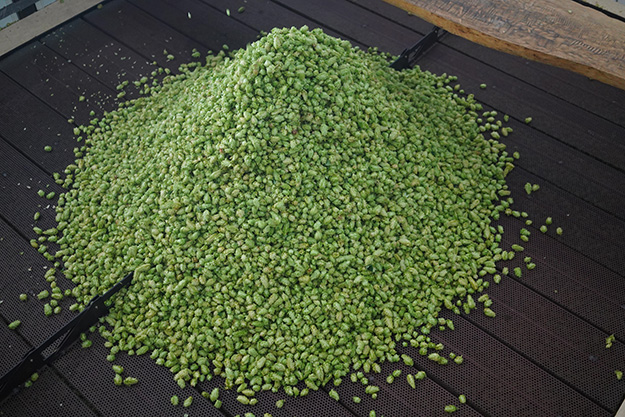
Sorted and cleaned hops. Photo ©2025 Chris Kilham

Houb’s artisanal beers. Photo ©2025 Chris Kilham
Over the course of several hours, Nebil and I go back and forth the few hundred yards between the harvest and drying. We glean more valuable information from Lucie, take photos, fly the camera drone, and keep out of the way of the video crew as they capture the scene. I walk along rows beside the tractor, taking photos and paying close attention to the way the harvester in the truck pulls down the hop vines. It is a practiced art, no doubt. In the late afternoon, Nebil and I pack our gear back into our car and bid adieu to Lucie, the people at Houb’s, and the videographers. More than two-thirds of the hops have been harvested in one day. It never rained. We did have to pick gooey clods of mud out of our boot lugs with sticks. As we head out of the farm, the air is redolent with a delightful profusion of aromatic hops terpenes, and the sun is dipping behind the green forested hills of Aquitaine.
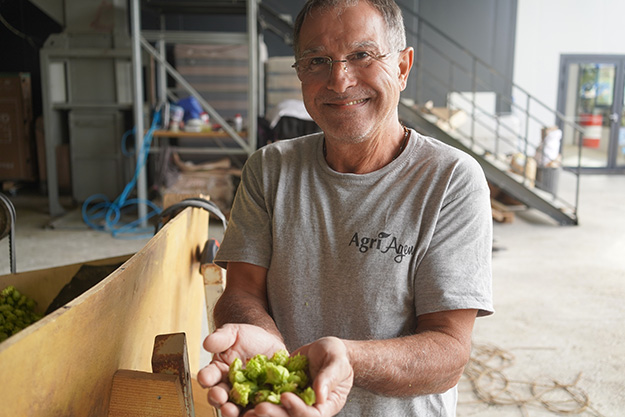
Hops pride. Photo ©2025 Chris Kilham

Hops in hands. Photo ©2025 Chris Kilham
* Hop was previously classified in Moraceae, the mulberry family, for reasons that may have been more about politics than taxonomy.
HerbalEGram | Volume 22, 2025 | February 2025
References
Korpelainen H, Pietiläinen M. Hop (Humulus lupulus L.): Traditional and present use, and future potential. Economic Botany. 2021;75:302-322. Available at: https://link.springer.com/article/10.1007/s12231-021-09528-1. Accessed February 3, 2025.
The craft beer market — France (2023). Businesscoot website. November 20, 2023. Available at: www.businesscoot.com/en/study/the-craft-beer-market-france. Accessed February 3, 2025.
De Keukeleire D, Vindevogel J, Szücs R, Sandra P. The history and analytical chemistry of beer bitter acids. TrAC Trends in Analytical Chemistry. 1992;11(8):275-280. Available at: www.sciencedirect.com/science/article/abs/pii/0165993692870893. Accessed February 3, 2025.
Scoblionkov D. The beer that made Sumerians famous. The New York Times. March 24, 1993. Available at: https://timesmachine.nytimes.com/timesmachine/1993/03/24/598493.html. Accessed February 3, 2025.
Appendix: The Hymn to Ninkasi (translation by Miguel Civil). University of Massachusetts website. May 5, 2005. Available at: https://people.umass.edu/mrenaud/kas/poem.htm. Accessed February 3, 2025.
National Hop Report: 2023 Hop Production Up 2 Percent From Last Year. US Department of Agriculture website. December 20, 2023. Available at: www.nass.usda.gov/Statistics_by_State/Regional_Office/Northwest/includes.... Accessed February 3, 2025.
We’ve created the hoppiest beer ever documented ... Hoo Lawd! [press release]. Milton, DE: Dogfish Head Brewing; November 23, 2015. Available at: www.dogfish.com/blog/weve-created-hoppiest-beer-ever-documented-hoo-lawd. Accessed February 3, 2025.
Kontek B, Jedrejek D, Oleszek W, Olas B. Antiradical and antioxidant activity in vitro of hops-derived extracts rich in bitter acids and xanthohumol. Industrial Crops and Products. 2021;161:113208. Available at: www.sciencedirect.com/science/article/abs/pii/S0926669020311250. Accessed February 5, 2025.
Clarke RC, Merlin MD. Cannabis: Evolution and Ethnobotany. Berkeley, CA: University of California Press; 2013.
Nuutinen T. Medicinal properties of terpenes found in Cannabis sativa and Humulus lupulus. European Journal of Medicinal Chemistry. 2018;157:198-228. Available at: www.sciencedirect.com/science/article/abs/pii/S0223523418306408. Accessed February 3, 2025.
Mony TJ, Elahi F, Choi JW, Park SJ. Neuropharmacological effects of terpenoids on preclinical animal models of psychiatric disorders: A review. Antioxidants (Basel). 2022;11(9):1834. Available at: https://pmc.ncbi.nlm.nih.gov/articles/PMC9495487/. Accessed February 5, 2025.
Hops perfumes. Fragrantica website. Available at: www.fragrantica.com/notes/Hops-572.html. Accessed February 3, 2025.
Sun S, Wang X, Yuan A, et al. Chemical constituents and bioactivities of hops (Humulus lupulus L.) and their effects on beer-related microorganisms. Food and Energy Security. 2022;11(2):e367. Available at: https://onlinelibrary.wiley.com/doi/full/10.1002/fes3.367. Accessed February 4, 2025.
Zanoli P, Zavatti M. Pharmacognostic and pharmacological profile of Humulus lupulus L. J Ethnopharmacol. 2008;116(3):383-396. Available at: https://pubmed.ncbi.nlm.nih.gov/18308492/. Accessed February 4, 2025.
Carbone K, Gervasi F. An updated review of the genus Humulus: A valuable source of bioactive compounds for health and disease prevention. Plants (Basel). 2022;11(24):3434. Available at: https://pmc.ncbi.nlm.nih.gov/articles/PMC9782902/. Accessed February 5, 2025.
Lupuli Flos. In: ESCOP Monographs: The Scientific Foundation for Herbal Medicinal Products. 2nd ed. Exeter, UK: European Scientific Cooperative on Phytotherapy and Thieme; 2003.
Hops. In: Blumenthal M, Goldberg A, Brinkmann J, eds. Herbal Medicine: Expanded Commission E Monographs. Austin, TX and Newton, MA: American Botanical Council and Integrative Medicine Communications; 2000. Available at: www.herbalgram.org/resources/expanded-commission-e-monographs/hops/. Accessed February 5, 2025.
Vahedpoorfard Z, Ferdosi S, Rahimi H, Motedayyen H. Effect of Humulus lupulus L. (hop) on postmenopausal sexual dysfunction: A randomized clinical trial. Int J Clin Pract. 2023;2023:9528335. Available at: https://pmc.ncbi.nlm.nih.gov/articles/PMC10125751/. Accessed February 5, 2025.
Fahle A, Bereswill S, Heimesaat MM. Antibacterial effects of biologically active ingredients in hop provide promising options to fight infections by pathogens including multi-drug resistant bacteria. European Journal of Microbiology and Immunology. 2022;12(1):22-30. Available at: https://akjournals.com/view/journals/1886/12/1/article-p22.xml. Accessed February 5, 2025.
Jiang CH, Sun TL, Xiang DX, Wei SS, Li WQ. Anticancer activity and mechanism of xanthohumol: A prenylated flavonoid from hops (Humulus lupulus L.). Front Pharmacol. 2018;9:530. Available at: https://pmc.ncbi.nlm.nih.gov/articles/PMC5972274/. Accessed February 5, 2025.

